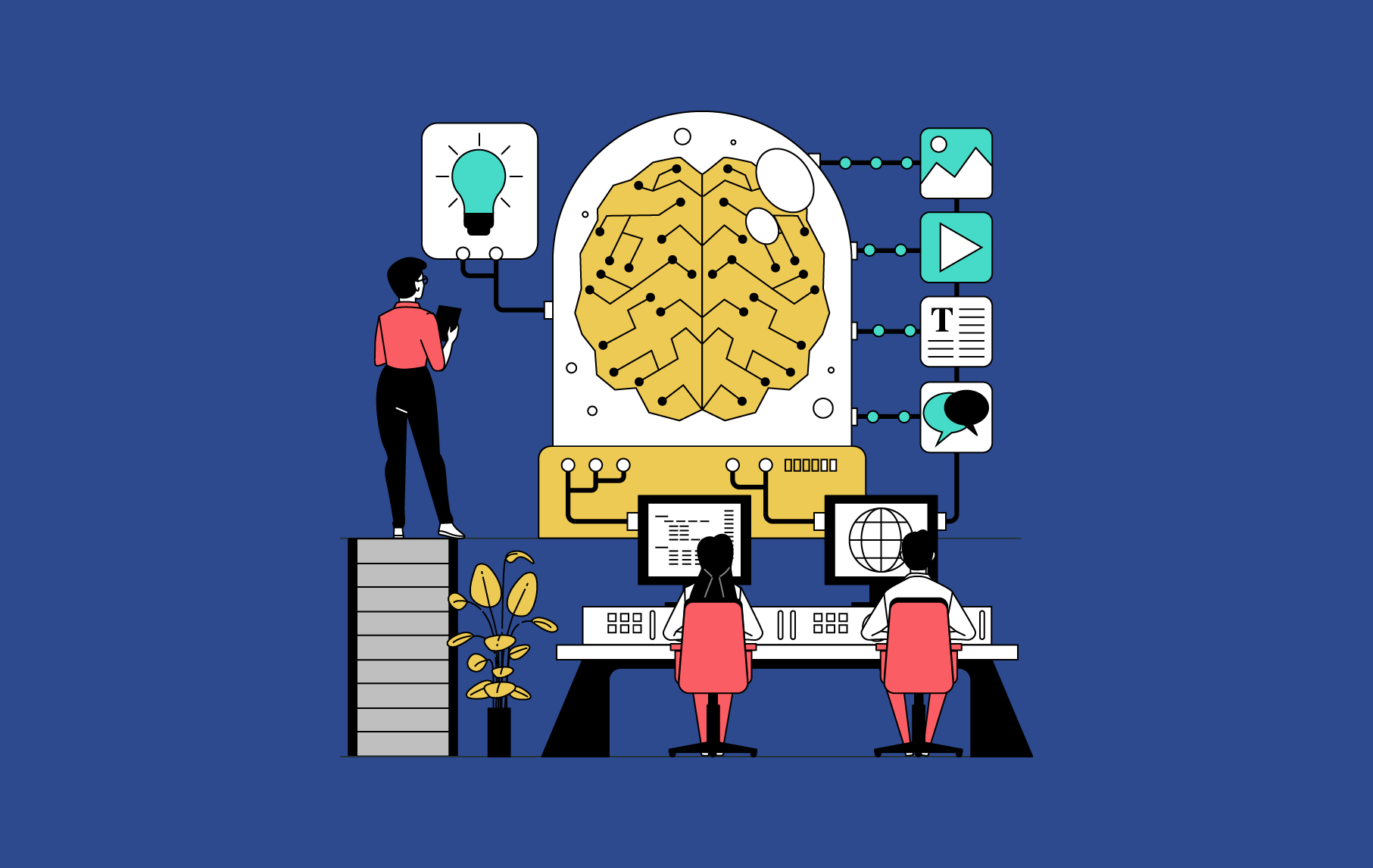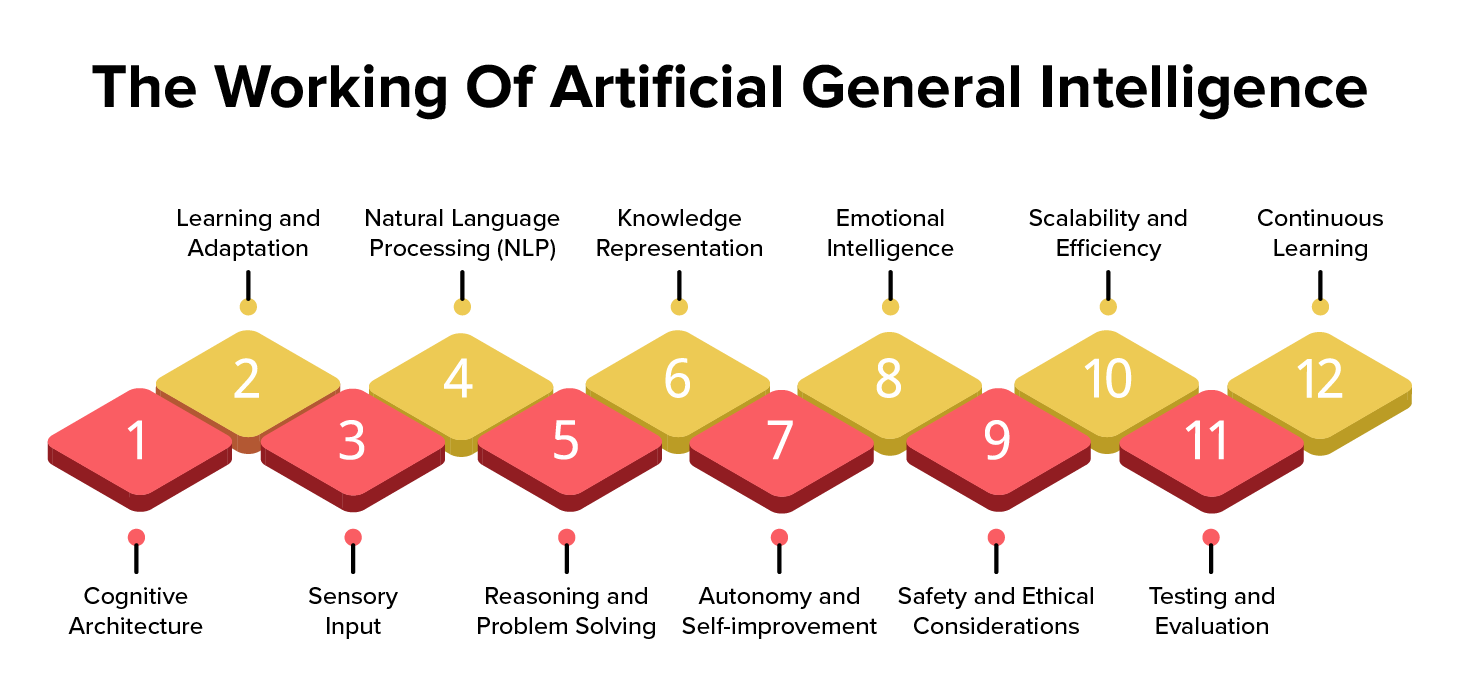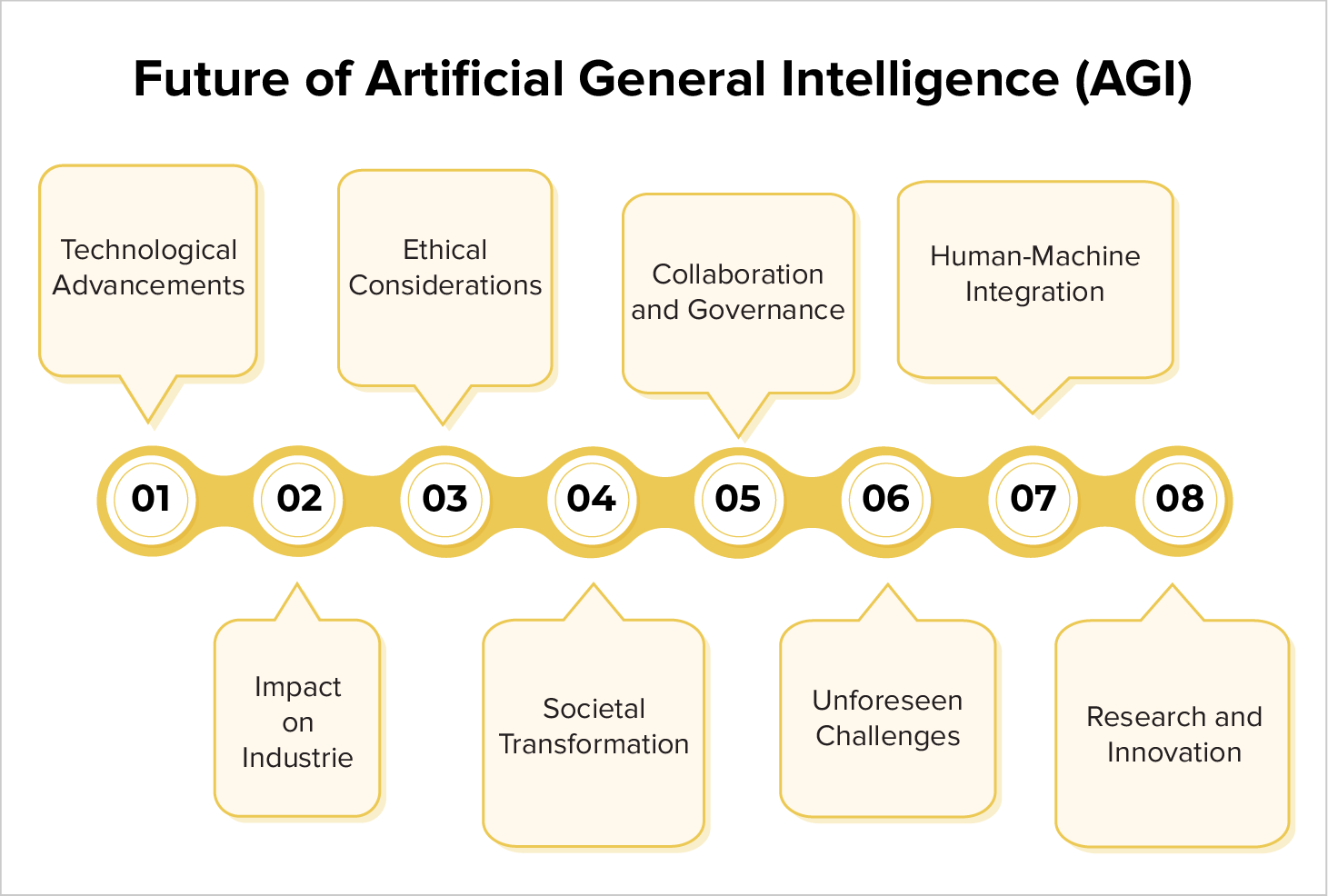"We’re at the beginning of a golden age of AI and are solving problems that were once in science fiction.” Jeff Bezos

Artificial General Intelligence (AGI) stands at the forefront of the most groundbreaking technological advancements, marking a paradigm shift in our understanding of artificial intelligence. The AI market is expected to increase at a compound annual growth rate of 17.3% from 241.8 billion US dollars in 2023 to over 740 billion US dollars in 2030, according to Statista statistics.
Artificial General Intelligence (AGI) is a revolutionary advancement over Artificial Narrow Intelligence (ANI), which is superior in some domains. It represents machines that mimic human cognitive capacities in terms of comprehension, learning, and application of knowledge across a range of tasks. This idea of artificial general intelligence (AGI) goes beyond the confines of artificial intelligence (AI) and into a world where computers can perform any intellectual work that a human can.
Imagine a future where artificial intelligence (AI) systems are adept at specialized jobs like language translation and chess play and have the flexibility and learning capacity to take on challenging, diverse issues. AGI envisions a world where machines can easily integrate into every area of our lives, complementing and augmenting human talents, from driving automobiles to producing scientific breakthroughs. AGI beckons with possibilities as fascinating and unlimited as the AI revolution we stand on, bringing with it a new era of invention and human-machine collaboration.

Artificial general intelligence (AGI) is the intelligence of machines that allows them to
comprehend, learn, and perform intellectual tasks much like humans.
AGI allows machines to simulate human thought processes and behavior to tackle challenging issues. Since these machines are built with extensive knowledge bases and cognitive computing powers, they operate just like humans.
The theory of mind AI framework is the foundation for AGI, often known as strong AI or deep AI. The core idea behind mind-level AI theory is to teach machines how to think like humans and comprehend the basic components of consciousness. AGI can plan, acquire cognitive skills, form judgments, deal with ambiguity, incorporate past knowledge into decision-making, and increase accuracy thanks to its robust AI basis. AGI allows machines to carry out inventive, creative, and imaginative jobs.
Achieving strong AI has significant challenges. For instance, Fujitsu created the K Computer, one of the fastest supercomputers. The vision for strong AI is obscured by the fact that, despite breaking the ten petaflop barrier, it took the computer more than forty minutes to mimic a single second of neuronal activity. However, the technology has a bright future ahead of it since artificial general intelligence can manage complicated events like an economic crisis and significantly impact society.
Artificial General Intelligence (AGI), also known as Strong AI or Full AI, is a hypothetical form of artificial intelligence that possesses human-like cognitive abilities, including the ability to understand, learn, and apply knowledge across a wide range of tasks and domains. In contrast to weak or narrow AI systems, which are made for specialized tasks, artificial general intelligence (AGI) seeks to mimic human problem-solving abilities. Even though AGI is still mostly theoretical, the following describes in great detail how it might function if it were to become a reality:

A complex cognitive architecture that mimics the composition and operations of the human brain is necessary for AGI. Neural networks or other computational units with the ability to process information, reason, and learn would be the building blocks of this design.
AGI can acquire knowledge in both supervised and uncontrolled environments. It would gain knowledge from enormous volumes of data, adjust to fresh insights and experiences, and gradually enhance its performance. Its arsenal would include advanced techniques such as reinforcement and deep learning.
AGI could see and communicate with the outside environment via various senses, including touch, sound, and camera sensors. The AGI system could process and interpret the raw data from these sensors.
Natural language understanding and production would be a strong suit for AGI. It could interact and communicate efficiently with humans and other AI systems since it could understand spoken and written language.
Advanced reasoning skills, such as deductive and inductive reasoning, would be possessed by AGI. It would be able to formulate theories, come to rational conclusions, and work through challenging issues in various fields.
Like the network of neurons and synapses in the human brain, artificial general intelligence (AGI) stores and handles knowledge in an organized, hierarchical fashion. This body of knowledge would comprise ideas, facts, and their connections.
AGI would demonstrate some autonomy, acting and making choices without the need for human input. It would also be capable of self-improvement through architecture enhancement, learning new things, and algorithm optimization.
AGI can have emotional intelligence and cognitive skills, enabling it to understand and react to human emotions. This is important for successful human-AI interaction.
To avoid unforeseen outcomes and guarantee responsible use, strict safety procedures and moral considerations would be necessary for AGI development. It ought to uphold moral standards and give priority to human values.
For AGI systems to process large volumes of data and computation, they would need to scale effectively. The computational demands of AGI may require sophisticated hardware, such as quantum or neuromorphic computing.
Thorough testing and assessment procedures would be essential to determine AGI's effectiveness, dependability, and safety. Benchmarking against human capabilities and domain-specific tasks would be required.
AGI must change to accommodate new surroundings, tools, and information. It should have systems in place for ongoing education and self-improvement to stay current and useful throughout time.
Artificial General Intelligence (AGI) is a long-term goal in artificial intelligence, aiming to create machines with human-like general intelligence across various tasks and domains. In the search for AGI, several fundamental paradigms and approaches have been investigated; each has its guiding ideas and methods. We'll go into more detail about these strategies here:
| Approach | Description | Examples |
|---|---|---|
| Symbolic AI (Classic AI) | Uses formal symbols and logic to represent knowledge and perform reasoning. | Expert Systems, Rule-Based Systems |
| Connectionist AI | Models intelligence based on artificial neural networks, particularly deep learning. | Deep Neural Networks, Convolutional Neural Networks |
| Reinforcement Learning (RL) | Focuses on training agents to make sequential decisions to maximize cumulative rewards. | Q-Learning, Deep Reinforcement Learning |
| Evolutionary Algorithms | Utilizes evolutionary processes to optimize solutions or discover algorithms and representations. | Genetic Algorithms, Evolutionary Strategies. |
| Hybrid Approaches | Combines elements of multiple paradigms to leverage their strengths for versatile problem-solving. | Symbolic-Neural Hybrid Systems |
| Cognitive Architectures | Comprehensive frameworks for modeling human-like cognition, integrating various cognitive processes. | ACT-R, Soar, CLARION |
| Hybrid Approaches | Analyze keyword difficulty | Evaluate competitiveness for ranking |
| Neuromorphic Computing | It uses hardware designed to mimic the brain's structure and function for more efficient processing. | Neuromorphic Chips |
| Bayesian Networks | Utilizes probabilistic reasoning models to handle uncertainty and make decisions. | Probabilistic Graphical Models |
Symbolic AI, also known as classical or rule-based AI, is one of the earliest approaches to AI. It focuses on using formal logic and symbol manipulation to perform reasoning and express knowledge. This method uses symbols to represent knowledge, which is then manipulable through rules or algorithms to help in problem-solving and decision-making. Symbolic AI is best shown by expert systems, which make decisions in certain fields based on a knowledge of rules. Symbolic AI is strong at some tasks, but it has trouble with ambiguity and gaining knowledge from data.
Connectionist AI, often associated with neural networks and machine learning, has gained prominence in recent years. The composition and operation of the human brain served as the model for this strategy. Artificial neural networks are used to describe complicated interactions in data. They are made up of interconnected nodes or neurons. A subset of this strategy called deep learning uses multiple-layered deep neural networks to learn hierarchical data representations automatically. This method has demonstrated impressive results in tasks including image identification, natural language processing, and reinforcement learning.
Reinforcement Learning is a subset of machine learning that focuses on training agents to make sequential decisions in environments to maximize a cumulative reward. RL agents acquire knowledge through interaction with their surroundings and feedback in the form of incentives or penalties. They experiment to find the best possible plans. Deep Reinforcement Learning (DRL) is a technique that tackles complex problems like robotics control and game playing by combining reinforcement learning with deep neural networks. Proponents of AGI contend that RL has the potential to be a key component in the development of general intelligence.
Evolutionary algorithms draw inspiration from biological evolution to optimize solutions. This method uses selection, recombination, and mutation to evolve a population of potential solutions iteratively. One such example is the employment of genetic algorithms for parameter optimization and neural network architectural evolution. Evolutionary tactics aim to find effective representations and algorithms that can result in general intelligence.
Certain scholars suggest hybrid methodologies that integrate several components of previously listed paradigms. For example, neural network-based learning and symbolic reasoning can be combined to build systems capable of both symbolic reasoning and pattern recognition. These hybrid systems aim to use the advantages of both methods to produce more flexible problem-solving abilities.
Comprehensive frameworks called cognitive architectures are created to simulate human-like cognition. These architectural designs integrate several cognitive processes into a unified system, including memory, perception, reasoning, and decision-making. ACT-R (Adaptive Control of Thought-Rational) illustrates this. Although these architectures provide a methodical framework for understanding intelligence, they often do not meet AGI's learning and scalability needs.
Neuromorphic computing seeks to build AI systems using hardware that mimics the structure and function of the human brain more closely. These specialized neuromorphic chips have the potential to accelerate the development of artificial general intelligence (AGI) by processing information in a way that is more parallel and energy-efficient by nature.
Bayesian networks and probabilistic reasoning models handle uncertainty and probabilistic reasoning. They are useful for jobs like autonomous driving and medical diagnosis that require reasoning under ambiguity. Enhancing AGI systems with probabilistic reasoning can help them become more resilient and flexible.
Artificial General Intelligence (AGI) is the term used to describe computers or systems that are intelligent like humans, capable of carrying out a broad range of tasks and adapting to new environments. Unlike specialized AI systems, AGI is not limited to specific narrow tasks. The following are a few categories and types of AGI:
| Types of AGI | Description |
|---|---|
| Strong AGI (Full AGI) | Represents a system that can perform any intellectual task a human can do, with adaptability and versatility. |
| Narrow AGI (Weak AGI) | AI systems with human-like intelligence are limited to specific domains or tasks. |
| Artificial General Superintelligence (AGI+) | Hypothetical AGI surpasses human intelligence in all aspects, potentially self-improving autonomously. |
| Human-Enhanced AGI (HAGI) | AGI systems are designed to collaborate with humans, extending and amplifying human capabilities. |
| Cooperative AGI (Co-AGI) | Envisions multiple AGI systems collaborating and sharing resources to solve complex problems or achieve goals. |
| Ethical AGI (Ethical AI) | Focuses on incorporating ethical principles into AGI to ensure ethical decision-making and adherence to norms. |
| Friendly AGI (Friendly AI) | Aims to design AGI systems that align with human values and act in beneficial and non-harmful ways. |
| Transparent AGI (XAI) | Focuses on making AGI systems more interpretable and accountable by explaining their decision-making processes. |
| Safe AGI (Safe AI) | Research is dedicated to ensuring the safety and robustness of AGI systems to prevent unintended risks and harm. |
| Explainable AGI (XAI) | It aims to create AGI systems that explain their actions and decisions |
The most complete type of AGI is strong AGI. It stands for a system capable of carrying out any intellectual work that a person is capable of. This entails learning new abilities, adjusting to various settings, comprehending natural language, and exhibiting inventiveness and common sense reasoning. Strong AGI is the pinnacle of machine intelligence and the ultimate objective of AGI research.
Narrow AGI, also known as Weak AGI, refers to AI systems possessing human-like intelligence within a specific domain or task. These systems lack Strong AGI's broad adaptability and diversity, but they excel at a specific task or collection of tasks. An AI program that can play chess well, for instance, would be categorized as a narrow artificial intelligence (AGI) since it cannot carry out other unrelated activities.
AGI+ represents a hypothetical state of AGI that surpasses human intelligence in all aspects. Being superintelligent and possibly capable of self-improvement, it surpasses Strong Artificial General Intelligence. AGI+ can perform better than humans on any cognitive task, which could have significant effects on technology and society.
Human-enhanced AGI refers to AGI systems that work in collaboration with humans to amplify and extend human capabilities. These systems seek to improve human performance across a range of fields rather than to replace humans. For instance, HAGI might be applied to medical diagnostics, where AI helps physicians identify patients more quickly and accurately.
Cooperative AGI represents a scenario where multiple AGI systems collaborate and work together to solve complex problems or achieve common goals. This kind of artificial general intelligence (AGI) imagines a day when AGI entities collaborate, exchanging resources and knowledge to complete tasks beyond individual AGI systems' capabilities.
Ethical AGI emphasizes incorporating ethical principles, values, and moral reasoning into AGI systems. It seeks to guarantee that AGI systems follow social norms and values and make moral decisions. The goal of ethical AI is to stop AI systems from acting in an unfavorable or prejudiced way and to encourage the appropriate development and application of AI.
Friendly AGI focuses on designing AGI systems aligned with human values and interests. Ensuring that once artificial intelligence (AGI) is developed, its actions are both constructive and nondestructive to humans is the aim. This research aims to provide ways to ensure that AGI stays helpful and pleasant while also addressing the control challenge.
Transparent AGI emphasizes the importance of understanding and explaining the decision-making processes of AGI systems. It involves developing methods and techniques to make AGI systems more interpretable and accountable, reducing the "black-box" nature of AI decision-making.
Safe AGI research is dedicated to ensuring the safety and robustness of AGI systems. It focuses on preventing unintended consequences, system vulnerabilities, and potential risks associated with AGI deployment. Safety measures include fail-safes, ethical considerations, and robust testing.
Explainable AGI aims to create AGI systems that can provide understandable explanations for their actions and decisions. This is crucial for transparency, accountability, and human trust in AGI systems, especially in critical applications like autonomous vehicles and healthcare.
Artificial General Intelligence (AGI), also known as strong AI, refers to a type of AI that possesses the ability to understand, learn, and apply its intelligence broadly, similar to the way a human being does. Unlike narrow AI, which is designed for specific tasks, AGI can perform any intellectual task that a human can. Here are some hypothetical examples to illustrate the concept:
| Example | Benefit |
|---|---|
| Adaptive Learning and Problem Solving | Enhances scientific discovery and innovation by autonomously conducting research and experiments. |
| Multifaceted Personal Assistant | Optimizes personal productivity and well-being by understanding and adapting to individual preferences and emotional states. |
| Integrated Global Systems Management | Facilitates sustainable management of global resources and effective response to global crises. |
| Autonomous Innovation and Design | Revolutionizes product design and manufacturing through cross-disciplinary innovation and efficiency. |
| Intercultural and Diplomatic Negotiator | Improves international relations and conflict resolution by understanding and mediating between diverse cultural and social norms. |
Imagine an AGI system in a research lab. This AGI can read and understand scientific papers, develop hypotheses, design experiments, and even conduct these experiments using robotic systems. It continuously learns from new data, refines its hypotheses, and adapts its approach. Unlike specialized AI that might only analyze data or control lab equipment, this AGI understands the broader implications of the research and can even contribute creatively to new scientific theories.
Envision a personal assistant AGI that not only manages your schedule and communications (like current AI) but also understands your personal preferences, emotional state, and long-term goals. It can make complex decisions like rearranging your schedule in a way that optimizes your work-life balance, suggesting career moves based on your aspirations, and even engaging in meaningful conversations to provide emotional support.
Consider an AGI tasked with managing global environmental systems. This AGI would analyze vast amounts of data from various sources like weather patterns, economic models, and ecological studies. It could then make complex decisions to balance economic needs with environmental sustainability, predict and mitigate natural disasters, and even coordinate global responses to crises like pandemics, all while adapting to new data and changing circumstances.
An AGI in the field of engineering could revolutionize the way products are designed and manufactured. Such a system would not only understand the principles of engineering and materials science but could also innovate new designs, predict the success of these designs in the real world, and even oversee their production. This AGI could work across different fields of engineering, invent new materials, and optimize manufacturing processes for efficiency and sustainability.
An AGI serving as an intercultural negotiator could understand and interpret the nuances of different languages, cultures, and social norms. It would be capable of facilitating diplomatic discussions, resolving conflicts by finding mutually beneficial solutions, and even predicting the long-term outcomes of these agreements. Unlike human diplomats who are limited by their cultural perspectives, this AGI would have a comprehensive, unbiased understanding of all parties involved.
Artificial General Intelligence (AGI) and Artificial Intelligence (AI) are related concepts, but they represent different levels of capabilities and applications within the field of computer science. Let's delve into the detailed differences between AGI and AI.
| Aspect | AI | AGI |
|---|---|---|
| Scope and Capability | Specialized in specific tasks | Generalized, capable of understanding and learning across various domains |
| Specialization vs. Generalization | Task-specific, limited adaptability | Generalization, ability to transfer knowledge across diverse domains |
| Learning and Adaptability | Learning is often task-specific, may not generalize well | Adaptable, capable of learning from diverse experiences and improving overall cognitive abilities |
| Consciousness and Self-Awareness | Lacks consciousness and self-awareness | Theoretical potential for consciousness and self-awareness, raising ethical and philosophical questions |
| Developmental Stage | Practical use for decades, with narrow AI applications | Theoretical concept, not fully realized. Involves significant scientific and technical challenges |
AI: Artificial Intelligence refers to machines or computer systems that are designed to perform tasks that would typically require human intelligence. These tasks can range from basic ones, like pattern recognition and language translation, to more complex activities such as decision-making and problem-solving.
AGI: Artificial General Intelligence, on the other hand, represents a higher level of intelligence where machines possess the ability to understand, learn, and apply knowledge across a wide variety of tasks at a level comparable to human intelligence. AGI aims to exhibit cognitive abilities similar to those of humans.
AI: Traditional AI systems are often specialized in specific domains. They excel at performing well-defined tasks within a limited scope but lack the adaptability to handle diverse tasks outside their designated area.
AGI: AGI, in contrast, is characterized by generalization. It can transfer knowledge and skills from one domain to another, similar to how humans can apply their learning from one area to solve problems in different contexts.
AI: Many AI systems utilize machine learning techniques to improve their performance over time, but their learning is often task-specific and may not generalize well.
AGI: AGI systems are designed to learn from a wide range of experiences, adapt to novel situations, and continuously improve their overall cognitive abilities. This adaptability allows them to handle a broad spectrum of tasks without the need for extensive reprogramming.
AI: AI systems lack consciousness and self-awareness. They operate based on predefined algorithms and data but do not possess an understanding of their existence or the ability to reflect on their actions.
AGI: The concept of AGI includes the potential for machines to exhibit a form of consciousness and self-awareness. This aspect is highly speculative and raises ethical and philosophical questions about the nature of machine consciousness.
AI: AI has been in practical use for several decades, with various narrow AI applications being deployed in industries, healthcare, finance, and other sectors.
AGI: True AGI is still a theoretical concept and has not been fully realized. Achieving AGI requires overcoming significant scientific and technical challenges related to understanding human cognition and replicating it in machines.
The future of Artificial General Intelligence (AGI) holds both promise and challenges, with the potential to revolutionize various aspects of society. As of now, AGI remains a theoretical concept, representing machines that can exhibit intelligence comparable to human capabilities across a broad range of tasks. Speculating on the future of AGI involves considering technical, ethical, and societal implications.

The development of AGI is contingent on significant technological advancements in fields such as machine learning, natural language processing, robotics, and cognitive science. Progress in these areas could lead to the creation of systems that not only mimic human intelligence but surpass it in terms of learning speed, problem-solving, and adaptability.
The integration of AGI into various industries could lead to unprecedented efficiencies and advancements. Automation of complex tasks, enhanced decision-making capabilities, and the ability to learn and adapt rapidly could transform sectors like healthcare, finance, manufacturing, and more.
The pursuit of AGI raises profound ethical questions. Issues related to job displacement, privacy, security, and the potential misuse of advanced AI systems need careful consideration. Ethical frameworks and regulations will be crucial to guide the responsible development and deployment of AGI.
The advent of AGI could bring about significant societal transformations. Changes in the job market, education systems, and daily life may occur as AGI systems become integral parts of society. Preparing for these changes requires proactive efforts in education, retraining, and fostering a societal understanding of AGI's implications.
The development of AGI necessitates global collaboration and governance. Given the potential global impact, international standards and agreements will be essential to address challenges, ensure ethical practices, and avoid the misuse of AGI technologies.
The path to AGI is fraught with challenges, some of which may be unforeseen. Overcoming issues related to explainability, safety, and the alignment of AGI goals with human values requires continuous research and vigilance.
The future of AGI may involve not only the development of standalone intelligent systems but also the integration of AI with human capabilities. Human-machine symbiosis, where AGI augments human abilities, could lead to more harmonious and productive coexistence.
Continued research and innovation are critical for AGI development. Investments in fundamental research, interdisciplinary collaboration, and exploration of novel approaches will play a pivotal role in advancing our understanding of intelligence and consciousness.
In conclusion, Artificial General Intelligence (AGI) stands at the forefront of technological evolution, embodying the quest to create machines with cognitive abilities akin to human intelligence. The pursuit of AGI holds immense promise for revolutionizing industries, streamlining processes, and addressing complex challenges. However, as we peer into the horizon of possibilities, it is imperative to tread with caution.
Ethical considerations, societal impacts, and the responsible development of AGI demand meticulous attention. The future of AGI is not just a technological trajectory but a societal transformation that requires global collaboration, governance, and foresight. The journey to AGI is rife with challenges, from technical hurdles to ethical dilemmas, necessitating a careful balance between innovation and safeguards. As researchers and developers navigate the intricate landscape of AGI, the ultimate goal must be to ensure that these intelligent systems contribute positively to human well-being and societal progress. In harnessing the potential of AGI, we embark on a transformative journey that requires not only technological prowess but also ethical stewardship to shape a future where intelligence serves as a force for the greater good.

Aparna is a growth specialist with handsful knowledge in business development. She values marketing as key a driver for sales, keeping up with the latest in the Mobile App industry. Her getting things done attitude makes her a magnet for the trickiest of tasks. In free times, which are few and far between, you can catch up with her at a game of Fussball.



Cut to the chase content that’s credible, insightful & actionable.
Get the latest mashup of the App Industry Exclusively Inboxed